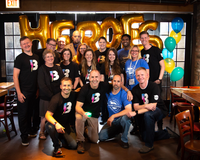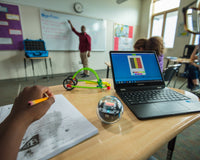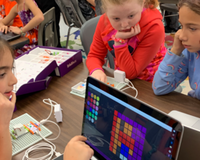As much as school is the place where students acquire new knowledge, it is also where they learn important social skills that enrich both their personal and future professional lives. Considering that, it’s important for educators to create conducive environments for social interaction in the classroom to help develop skills like communication, collaboration, group brainstorming, and problem solving.
STEM education can provide the perfect foundation for collective learning. STEM learning is inherently collaborative, encouraging students to learn alongside one another and in cooperation rather than in isolation. STEM can also be more inclusive by inviting students of all abilities to participate in learning—regardless of their learning style—allowing them to showcase their respective skills to bring projects to life. In this article, we look at how STEM and collaboration go hand in hand and how educators can use Sphero robots and activities to create an equitable environment for learning social skills.
Encouraging Collaboration with the Engineering Design Process
A good place to start for inclusive and collaborative STEM learning is with the engineering design process. The engineering design process is a problem-solving method used by engineers at all levels. The process combines multiple steps, including researching, brainstorming, designing, creating, and testing, to come up with innovative solutions. These steps can be used by groups of students to conduct STEM experiments and engage in collaborative STEM activities, like those offered by Sphero. Below are just a couple examples of Sphero activities that utilize the engineering design process to foster collaboration and innovation.
littleBits Invention Cycle
Sphero’s littleBits kits empower students to get creative and inventive while working in partnership. The littleBits Invention Cycle is a great lesson to get started with, as it introduces students to the engineering design process in a collaborative, practical way. Working in groups of two or three, students participate in a 15-minute design challenge to build a functional circuit using Bits and simple craft materials, like crumpled-up balls of paper. There are two aims to this activity: one is to make a circuit that can move as many paper balls as possible from one point to another, and the other is to have students think through their creation process and reflect on it after the activity in a group setting. At the end, students can reflect on the stages of the engineering design process they carried out: prototyping, testing, adjusting, sharing results, and getting feedback.
Sphero Blueprint
For middle and high school students, Sphero’s Blueprint engineering system provides an interactive platform to learn about mechanical engineering and robotics concepts in an engaging and hands-on way. The format for each Blueprint lesson includes introducing a specific engineering concept like levers or gears, exploring this concept through group research and experimental builds, and a final project based on the engineering design process which combines multiple different engineering concepts into a single model. Working as a team to bring these engineering concepts to life centers collaboration, allowing students to come up with ideas and work through challenges together. Above all, it can be a fun and educational experience that students enjoy.
In STEM learning, focusing on design processes like the littleBits Invention Cycle or Blueprint’s engineering design process, can help ensure social interaction isn’t left behind. Some parts of the process, such as brainstorming, testing and iterating, and communicating results, are impossible to do without collaborating and communicating with peers.
Defining Clear Roles in STEM Collaboration
Fostering a collaborative environment and encouraging social interactions is not just about making students work in groups. There are also helpful frameworks that educators can use to teach students how to work together strategically and productively. For example, teachers can work with students to define and assign roles for STEM activities, taking into account each student’s strengths to ensure that every team member is included.
“Defining clear roles can help build social interaction skills,” Tod Johnston, Sr. Education Content Manager for Sphero, explains. “In Sphero robot coding activities, asking students to take turns reading the instructions and programming the robot makes students work together. In engineering design lessons with littleBits or Blueprint, assigning roles such as the team lead, debugger, or recorder helps students all positively contribute. Developing communication, collaboration, and teamwork skills is essential to STEM learning.”
The structure that comes with assigning roles, even for younger students, has a number of benefits. For starters, it plays to students’ respective strengths and can help them understand where they excel. It can also help students learn different types of skills by seeing the strengths of their peers in action. This also has the benefit of helping to build greater understanding and empathy between students, even if they are very different. Teamwork is also vital to building confidence and showing students that even from a young age their voices and participation are important and valuable.
Finally, establishing defined roles within teamwork can help to create a shared sense of ownership over the project and greater accountability, especially compared to the all-too-common group work dynamic where one or two students take on most of the work and get all the credit.
Encouraging STEM collaboration
The classroom is where children learn how to interact with their peers and how to work together to achieve a shared goal. STEM activities can help educators to encourage social interaction in the classroom and teach students the real-world importance of critical thinking, communication, and collaboration. This teamwork can in turn help to cultivate other valuable skills needed in STEM, like collaborative brainstorming, design and creation, testing, and results discussion.
Find STEM education tools, activities, curriculum, and more from Sphero.
About the Author:
The Sphero Team
The Sphero Team is comprised of current and former educators, education content and curriculum writers, product designers, engineers, executive leadership, and other experts in their fields. Learn more about who we are and what we do at sphero.com/about.










